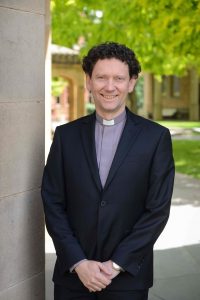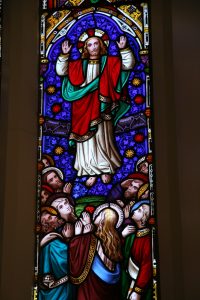 In the sanctuary of our Chapel here at Saints, on the right-hand side of the altar as you look at it, is a beautiful window. It is one of the windows crafted by William Wailes, who crafted almost all of the windows in the Chapel. They are admired for the bright nature of their colours. Indeed, if you compare them with the two windows in the sanctuary not made by Wailes, the Wailes windows are much brighter; the others are almost dull in comparison. I like this window. It is truly beautiful and it captures something of the Ascension of Jesus, as described in the book of Acts (Acts 1: 1–11). As a School we celebrated the Ascension on Thursday in Week 5.
In the sanctuary of our Chapel here at Saints, on the right-hand side of the altar as you look at it, is a beautiful window. It is one of the windows crafted by William Wailes, who crafted almost all of the windows in the Chapel. They are admired for the bright nature of their colours. Indeed, if you compare them with the two windows in the sanctuary not made by Wailes, the Wailes windows are much brighter; the others are almost dull in comparison. I like this window. It is truly beautiful and it captures something of the Ascension of Jesus, as described in the book of Acts (Acts 1: 1–11). As a School we celebrated the Ascension on Thursday in Week 5.
The only problem I have with the window, though, is that I can’t get the thought out of my mind, bearing in mind that Jesus is depicted as ascending up into the sky, that he’s doing the “half-superman”. His arms are half-way there, ready for take-off.
In year 10 RAVE we watch the action-packed film, The Matrix. It was quite revolutionary at the time of its release for the special effects it displayed, but it’s easy to get so caught up in the action and the special effects, that one can miss the underlying symbolism. The writers and directors, the Wachowski siblings, deliberately and methodically used the Gospels, particularly John’s Gospel, as the basis for the ideas behind the film and most of the symbolism in the film.
At the end of the Matrix, without ruining it for you, the main character, Neo, flies off into the sky. It is a symbol that he truly believes and accepts that he is “The One”, but it is also a symbol of Jesus’ Ascension. Again, the Wachowskis were being very deliberate: Neo flying off like superman is meant to symbolise Jesus ascending into heaven. For this scene they drew specifically on Luke’s description in the book of Acts.
So, if we work on this assumption that the Gospels are full of symbolism, that as well as describing events, the authors were trying to tell us things through the use of symbols and metaphors, what was Luke, the author of Acts, trying to tell us? This account of Jesus ascending into the heavens is also a symbol of something else – it’s not just about Jesus being a little bit like superman, or, at least, the superman bit is not the main point.
Luke is trying to tell us, ’No longer is Jesus limited to one place, one time.’ No longer is Jesus confined by the restrictions of his physical body. No longer is he just in one situation: first Century Palestine under Roman occupation and Jewish religious law. Without the Ascension, and more importantly the meaning of the Ascension, Jesus is simply a historical figure confined to 1st Century Palestine. Even though we have much more information about Jesus than most people of his time, without the symbolism of the Ascension, Jesus is a good man, even a great man, but one who is stuck in a relatively unimportant province of the Roman Empire and who died a criminal’s death around the year 30 A.D. But, with the Ascension understood, that all changes. Now Jesus transcends time and space. Now he is available to be our friend and companion, wherever we are, whatever we are doing, at whatever stage of life we find ourselves. So Jesus, the friend, the stories about whom I enjoyed as a young boy, listening to my father read the Gospel reading in his powerful bass voice each Sunday morning, is the same figure who was present with me in my teenage years here at Saints, and is the same figure whose presence I am still aware of these days. I won’t lie to you: I don’t sense his presence with me all the time, but sometimes I do. There are some places too, the Flinders Ranges is one, where I sense his spirit quite powerfully.
As the author of Acts, Luke is trying to tell us something extraordinary with his description of the Ascension: no longer is Jesus confined to one place and one time. He is above all that now; he hears our prayers wherever we are; he comes to us whenever we need him. So, do I still think of Jesus doing the half-superman, as the window in the sanctuary shows, a picture now supplemented by the memory of Neo doing the full superman at the end of The Matrix? Yes, I do, because images and symbols are helpful. But, like all symbols, the real meaning is to be found in what the symbol means. Jesus is all around us, he sees everything, he hears everything, and he comes to us in the hour of our greatest need.
The Reverend Dr Theo McCall
School Chaplain

The Ascension window in the Chapel crafted by William Wailes.
